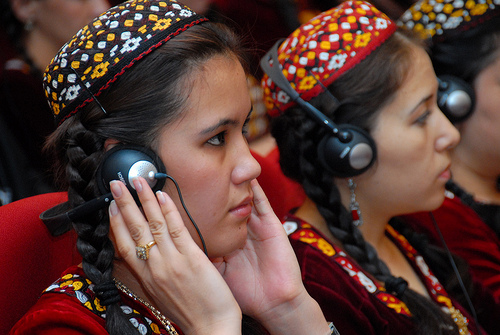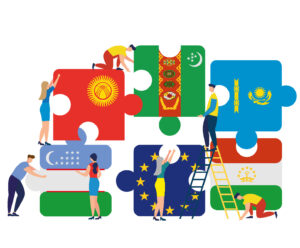The EU Education Initiative for Central Asia five years on: lessons learnt?

Download “The EU Education Initiative for Central Asia five years on: lessons learnt?”
EUCAM-Policy-Brief-30.pdf – Downloaded 588 times – 601.22 KBOver the past 20 years, developments in Central Asia’s education system have been mixed. The private education sector has been growing, especially in Kazakhstan and Kyrgyzstan, with fully-equipped classrooms and the application of best teaching practices. In the public sector, however, the general trend continues to point to a lack of financial and human resources, insufficient access to up-to- date materials and modern infrastructure, the politicisation of education, and ever- increasing corruption. The sporadic reforms initiated by Central Asian governments have sometimes even worsened the situation – Turkmenbashi’s regressive educational policies are the clearest example of this. Half of the region’s population is under 30 years of age, which means that about 25 million people are directly affected by the drastically degrading quality of education. If the European Union (EU) is serious about supporting educational reform in Central Asia, it needs to take local conditions into account when dealing with the challenges outlined above.
The EU-Central Asia Strategy for a New Partnership, adopted in 2007 and reaffirmed by the European Council in summer 2012, provided for the establishment of a regional European Education Initiative (EUEI) for Central Asia as part of the EU’s enhanced approach towards the region. The Initiative envisaged incorporating existing European programmes in the field of higher education and vocational education and training (VET), as well as developing new cooperation formats, such as the EU-Central Asia Education Platform. The EUEI thus seeks to provide a common framework for European support to the Central Asian education sector.
Five years on, the Initiative is often presented as a success story of EU engagement in the region. But looking more closely at the development and contents of the EUEI, this brief questions such a positive assessment. First, it examines the progress achieved since 2007, with a specific focus on the Initiative’s four components: the Central Asia Education Platform (CAEP); EU programmes in the field of higher education (Tempus and Erasmus Mundus); European engagement in vocational education and training; and the Central Asia Research and Education Network (CAREN). Secondly, it evaluates the successes and deficiencies of these elements. Finally, it provides an outlook that takes into account the 2012 Strategy Review and the EU’s internal reform in terms of education and training support instruments.
Central Asia Education Platform
The Central Asia Education Platform initially aimed ‘to step-up policy dialogue on education with Central Asia states’.(1) This dialogue was expected to include regular regional and bilateral discussions, as well as technical working groups that could help facilitate coordinated policy responses in the education sector. In 2008- 2009, a number of high-level meetings were held in order to prepare the ground for regular dialogues. However, progress was meagre and results were limited to repeated declarations of the Central Asian states’ commitment to regional cooperation.(2) In 2011, the European Commission signed a €1.8 million contract with a consortium of consultants to implement the CAEP project, even though not all Central Asian governments had yet given their official endorsement.
The Central Asia Education Platform was finally launched in February 2012. Throughout the year, its management team, which was based in Germany, paid several visits to Kyrgyzstan, Kazakhstan, Tajikistan and Uzbekistan, with the aim of familiarising themselves with the field and analysing local needs and interests. In the first three countries, the needs-assessment involved a wide range of state and non-state stakeholders, but in Uzbekistan, it was not possible to secure the participation of education ministry officials. Turkmenistan proved to be particularly difficult: the CAEP management team was not able to visit the country.
After the needs-assessment, three thematic lines were defined: teacher education and training, quality of higher education and VET, and the interaction of VET and higher education. Hopes were high within EU institutions and the implementing consultancies that an official endorsement could be reached after the EU- Central Asia foreign ministers’ meeting on 27 November 2012. But Uzbekistan and Turkmenistan showed no interest in high- level regional dialogues and thus the prospects of implementing the CAEP are bleak at best.
The Platform also envisioned the seemingly easier task of developing a website. The site is expected to publicise the policy dialogues and incorporate a database of all international education-related programmes and projects in Central Asia since 2007. This database could become a valuable tool for enhancing transparency and donor coordination. However, its success will depend on the ability of CAEP management to collect data on the fragmented activities of various donors, and on the donors’ voluntary commitment to provide this information.
Higher Education Support
Unlike the CAEP project, which emerged from the 2007 EU- Central Asia Strategy, the Erasmus Mundus and regional Tempus programmes began operating much earlier. Established in 1990 to assist Central and Eastern European countries in modernising their higher education sector, Tempus had already incorporated Central Asia as a partner region in the mid-1990s.(3) In 2007, the fourth and current cycle of the programme covering the period until 2013 was launched.
Tempus IV seeks to facilitate international cooperation and reform of higher education systems in partner countries, with the aim of bringing them closer to the Bologna Process and the European Higher Education Area.(4) Priority themes are defined around three building blocks: curricula reform, governance reform, and higher education and society. Curricula reform is to include the introduction of the three-level system – bachelor, master and doctorate. Governance reform mainly involves overhauling institutional management and quality assurance. And higher education and society will incorporate the development of university-enterprise partnerships.
Three kinds of actions have been supported in Central Asia. Joint Projects, implemented at the institutional level, involve the establishment of multilateral partnerships among higher education institutions. Structural Measures include the promotion of reform at the national level. And Accompanying Measures mainly consist of Tempus-related dissemination and information activities undertaken, for example, by National Tempus Offices in each Central Asian state. According to the European Commission, since its inception in Central Asia, Tempus has funded more than
200 projects. Approximately 120 higher education institutions in the region have been involved, with overall support totalling around €69 million.(5)
| Year | KZ | KG | TJ | TR | UZ |
|---|---|---|---|---|---|
| 2008 (1st call for proposals) | 10 | 4 | 2 | 1 | 3 |
| 2009 (2nd calls for proposals) | 3 | 3 | 3 | 1 | 4 |
| 2010 (3rd call for proposals) | 3 | 3 | 3 | 3 | 3 |
| 2011 (4th call for proposals) | 9 | 4 | 6 | N/A | 4 |
| 2012 (5th call for proposals) | 8 | 7 | N/A | N/A | N/A |
Erasmus Mundus was initiated in January 2004, extending the geographical scope of the Erasmus programme to non-European states. The project focused less on institutional reform and more on student and academic staff mobility, facilitated through joint higher education programmes and individual scholarships. In addition, in 2006 the Commission launched the Erasmus Mundus External Cooperation Window (ECW). This programme supported cross-national partnerships and cooperation exchanges between higher education institutions from Europe and from other regions, including Central Asia.
Between 2007 and 2009, projects involving Central Asian institutions were selected six times for ECW support, amounting to two projects per year. However, later projects mainly followed up or extended previous ones. They were coordinated by the same two European universities (Brussels-based Erasmus University College and the Eindhoven University of Technology), which specialise in cooperation with the region.
| Activity | KZ | KG | TJ | TR | UZ |
|---|---|---|---|---|---|
| Joint Degrees | 10 | 8 | 2 | 2 | 24 |
| Partnerships (ECW) | 176 | 127 | 54 | 41 | 140 |
In 2009, Erasmus Mundus was restructured to incorporate three Actions: (1) joint master’s and doctoral programmes and individual scholarships for participating in them; (2) partnership with third country higher education institutions and mobility scholarships (formerly ECW); and (3) projects promoting Europe as a destination for education. Between 2009 and 2012, 14 partnership projects that included Central Asia were supported under the current programme phase.(8) Since 2007, over 60 universities across the region, mainly from Kazakhstan and Uzbekistan, have been involved in Erasmus Mundus partnerships.
Vocational Education and Training
Public vocational (post-secondary non-academic) education in Central Asia has been particularly affected by financial difficulties and the decreasing quality of training. As a result, its attractiveness is diminishing, leaving few alternatives for youth whose families cannot afford university costs. The EU has set VET reform as a priority of its support to Central Asian education systems.
The EU finances the activities of the European Training Foundation (ETF), whose work in Central Asia largely focuses on skills development for poverty reduction and on the development of National Qualification Frameworks (NQFs). Its projects have been running since 2006, with a poverty reduction component active in Kazakhstan, Kyrgyzstan and Tajikistan. Building on this experience, since 2009 the ETF has launched several regional and cross-regional initiatives, mainly with the involvement of Kazakhstan, Kyrgyzstan and Tajikistan. These projects include improving skills for sustainable development, promoting work- based learning and converting local VET institutions into centres for life-long learning.
In recent years, ETF has also supported systematic reviews of the Central Asian VET sectors as part of the Torino Process, a European-led corporate initiative launched in 2010 with a long-term view to coordinate VET reforms. This has been complemented by country-specific actions, including, for instance, the professionalisation of VET staff in Kazakhstan, the development of life-long learning approaches to VET for vulnerable groups in Kyrgyzstan, the revision of vocational education content in Turkmenistan, and support to NQF development in Uzbekistan. All these projects are mainly funded under the European Commission’s Development Cooperation Instrument (DCI), with overall support amounting to more than €2.2 million for 2007-2012.(9)
Research networking through CAREN
In addition to EU support for Central Asia’s higher education and VET sectors, the 2007 Strategy envisages e-networking between European and Central Asian universities and research centres. It intends to build on the previously-established Virtual Silk Highway, a cross-regional project that set up computer networking throughout Eurasia via satellite technologies funded under the NATO Science Programme. In January 2009, the Central Asia Research and Education Network project was launched by the European Commission’s sub-contractor DANTE (Delivery of Advanced Network Technology to Europe). The project was created to replace existing satellite connections with a high-speed broadband Internet network interlinking more than 500 universities and research centres across the region. Eventually, this is supposed to pave the way for collaborative networks between Central Asian and European scientific institutions in pivotal areas such as environmental monitoring, telemedicine and seismology.
The initial project phase was planned to run until the end of 2011. Eighty per cent of the project costs, a total of €5 million, was contributed by the European Commission. The remaining 20 per cent was provided by the Central Asian states on a cost-sharing basis.(10) In July 2010, CAREN became operational, interlinking Kyrgyzstan, Tajikistan and Turkmenistan through their national research and education networks (NRENs). Kazakhstan joined in 2012, but Uzbekistan keeps postponing the date. Since the amount committed could not be spent by December 2011, the project phase has been prolonged so as to ensure the continued expansion of the network.
The Commission is now discussing the funding for the next CAREN phase, up to 2020. The success of this new phase will mainly depend on the Uzbek government’s willingness to cooperate and the ability of all participants to use the network in a meaningful way for innovative joint initiatives and (inter-) regional cooperation projects.
A success story?
After evaluating the overall impact and progress of the Education Initiative, its actual added-value remains questionable. Earlier programmes in the field of higher education and VET are clearly more advanced, and cooperation formats introduced after the 2007 Strategy are still in the early stages of development. The slow pace of the Education Platform is particularly significant. The main problem here is its initial conceptual approach. The idea of promoting education reform and sharing best practices through dialogue and coordination is not in itself futile, and is grounded in the EU’s own internal experience. However, from the outset, the Platform has been less of a tool for education reform than a means to facilitate inter-state cooperation in an environment where not all actors are interested in regional formats. As long as domestic needs vary, national interests prevail and true commitment is lacking (especially on the part of Uzbekistan and Turkmenistan), the Platform’s regional component will be doomed to fail.
At the same time, the lack of progress is hardly surprising, since the EU-Central Asia Education Platform did not take into account local needs and standpoints from the beginning. Systematic needs-assessments in the five states began only at a later stage: for VET, after the launch of the Torino Process in 2010, and within the CAEP project more generally, in 2012.
So far, both Tempus and Erasmus Mundus have proven to be quite successful, considering the number of partnership projects in selected Central Asian countries. But the programmes are very complex and inflexible in terms of grant application and project implementation procedures. This implies that they benefit institutions with higher initial capacities. Thus, unsurprisingly, the lists of projects selected for Tempus and Erasmus Mundus support often contain the same beneficiaries, with Central Asian universities generally playing the role of passive partners and Western institutions as the main grant applicants and project coordinators.
Another criticism specifically aimed at Tempus is its focus on promoting structural reforms associated with the European- led and Europe-centred Bologna Process. The process offers a model that would allow international comparability and acknowledgement of qualifications and degrees. While it may be attractive for some countries such as Kazakhstan and Kyrgyzstan, it implies comprehensive educational reforms that are sometimes either too challenging or simply not interesting to other Central Asian states. Thus, Turkmenistan and Uzbekistan would probably only take up a few elements of the programme. But Bologna à la carte might create more confusion than benefits, introducing new superficial elements without modifying the core of the old system. At the same time, the different levels of progress of Central Asian states regarding the Bologna Process create an additional difficulty for the EU’s regional approach towards education support.
Although linked to the Bologna Process through the principle of student and scholar mobility, Erasmus Mundus has a different set of objectives that might be easier to implement in Central Asia (with the probable exception of Turkmenistan). However, the sustainability of university partnerships and exchanges established under the programme remains uncertain, especially in the absence of continuous European funding. Even so, mobility works only one way. Since 2010, Europeans have not managed to receive individual Erasmus Mundus scholarships to go to Central Asia. Meanwhile, the number of Central Asian students and researchers going to Europe has increased. So, the programme indirectly fosters brain drain, instead of directly promoting an equal exchange. Of course, the positive aspects of Central Asians gaining study or research experience in Europe should not be underestimated. But Erasmus Mundus does not account for the existing structural inequalities in accessing excellent education. The programme benefits those who have already enjoyed better secondary and higher education and possess the necessary language skills to be selected for the scholarship.(11)
Finally, an evaluation of the CAREN project also demonstrates intra-regional cleavages, with Uzbekistan remaining an outsider. The provision of infrastructure and equipment in the other four Central Asian countries can be positively assessed. But what comes next is a much more challenging task: to utilise the infrastructure for mobilising intellectual resources and establishing sustainable partnerships, which was the original rationale behind the network.
Outlook
The Progress Report on the Implementation of the EU Strategy for Central Asia, issued by the European External Action Service and European Commission in summer 2012, points out that there is ‘scope for adjusting the focus of EU actions’ in order to increase their impact based on lessons learnt. This is also valid for the EU Education Initiative. The last five years of EU support to the education sector in Central Asia have demonstrated that initial expectations were too ambitious, especially with regard to the regional policy dialogue and to institutional reforms. The Initiative’s actual implementation should focus on what is achievable within the constraints of a fairly limited budget and the varying level of commitment from Central Asian partners. If the EUEI is to have a more systematic impact, European policymakers need to reconsider their objectives and adapt them to Central Asian realities based on the experience gained so far.
Adjustments to EUEI will be also necessary in view of the EU’s internal restructuring of instruments in the field of education support. After 2013, a new comprehensive funding scheme, ‘Erasmus for All’, proposed by the European Commission, is expected to replace the existing EU education and training programmes, including Erasmus Mundus and Tempus. This is due to increased funding coupled with structural and procedural simplification. This is positive news, considering that the main criticism of EU higher education support programmes concerned their complexity and resulting limited applicability in situations where local universities lack the human and technical capacities to be fully involved in the implementation. However, at the moment, it is unclear how ‘Erasmus for All’ will influence EU assistance to Central Asia, since the reform primarily emphasises European beneficiaries. The European Commission needs to make sure that the new programme does not neglect local needs and capacities, especially in countries beyond Europe.
- EEAS, The European Union and Central Asia: The New Partnership in Action, June 2009, p. 70, available at: http://eeas.europa.eu/central_asia/docs/2010_strategy_eu_centralasia_en.pdf.
- For a detailed review, see: P. Jones, ‘The EU-Central Asia Education Initiative’,
EUCAM Working Paper 9, February 2010. - Kazakhstan, Kyrgyzstan and Uzbekistan became official partners in 1994, Turkmenistan and Tajikistan in 1996. However, in Tajikistan, programme implementation did not start until 2004 because of the civil war in the 1990s.
- Launched in 1999, the Bologna Process aims to ensure that higher education systems in Europe are comparable, compatible and coherent. It put in motion a series of reforms that in 2010 resulted in the creation of the European Higher Education Area based on international cooperation and academic exchange.
- European Commission, ‘Education and Research’, EuropeAid, 3 September 2012, available at: http://ec.europa.eu/europeaid/where/asia/regional-cooperation-central-asia/education-and-research/index_en.htm.
- Information on Tempus IV projects in each country can be found at European Commission, ‘Tempus by country’, Education, Audiovisual and Culture Executive Agency, available at: http://eacea.ec.europa.eu/tempus/participating_countries/index_en.php. Information on projects selected in Tajikistan and Uzbekistan in 2012 and in Turkmenistan in 2011-2012 is not available.
- The table is based on data from Tempus and Erasmus Mundus partner country profiles available at: European Commission, ‘Tempus programme’, Education, Audiovisual and Culture Executive Agency, available at: http://eacea.ec.europa.eu/ tempus/tools/publications_en.php#6.
- For more information, see: European Commission, ‘Selected projects for Action 2 and External Cooperation Window’, Education, Audiovisual and Culture Executive Agency, available at: http://eacea.ec.europa.eu/erasmus_mundus/results_compendia/selected_projects_action_2_en.php.
- According to the ETF annual work programmes, see: ETF, ‘Work programme’, available at: http://www.etf.europa.eu/web.nsf/pages/Work_programme.
- CAREN, ‘The CAREN project’, available at: http://caren.dante.net/server/show/nav.2295.
- See also M.C. Merrill and A. Dukenbaev, ‘Youth and Higher Education’, in A. Warkotsch (ed.), The European Union and Central Asia (Oxford: Routledge, 2011).







